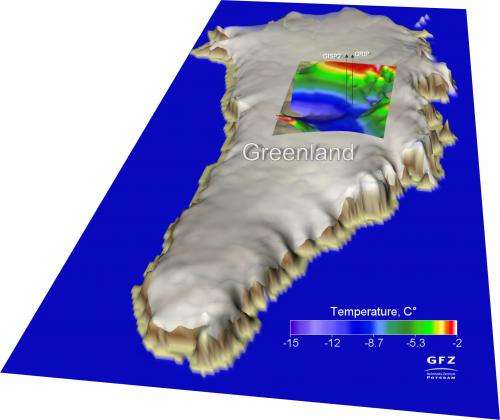Heat flow from Earth's mantle contributes to Greenland ice melting

The Greenland ice sheet is melting from below, caused by a high heat flow from the mantle into the lithosphere. This influence is very variable spatially and has its origin in an exceptionally thin lithosphere. Consequently, there is an increased heat flow from the mantle and a complex interplay between this geothermal heating and the Greenland ice sheet. The international research initiative IceGeoHeat led by the GFZ German Research Centre for Geosciences establishes in the current online issue of Nature Geoscience (Vol 6, August 11, 2013) that this effect cannot be neglected when modeling the ice sheet as part of a climate study.
The continental ice sheets play a central role in climate. Interactions and feedback processes between ice and temperature rise are complex and still a current research topic. The Greenland ice sheet loses about 227 gigatonnes of ice per year and contributes about 0.7 millimeters to the currently observed mean sea level change of about 3 mm per year. Existing model calculations, however, were based on a consideration of the ice cap and considered the effect of the lithosphere, i.e. the earth's crust and upper mantle, too simplistic and primarily mechanical: the ice presses the crust down due to its weight. GFZ scientists Alexey Petrunin and Irina Rogozhina have now coupled an ice/climate model with a thermo-mechanical model for the Greenland lithosphere. "We have run the model over a simulated period of three million years, and taken into account measurements from ice cores and independent magnetic and seismic data", says Petrunin. "Our model calculations are in good agreement with the measurements. Both the thickness of the ice sheet as well as the temperature at its base are depicted very accurately. "
The model can even explain the difference in temperature measured at two adjacent drill holes: the thickness of the Greenland lithosphere and thus the geothermal heat flow varies greatly in narrow confines.
What does this mean for climate modeling? "The temperature at the base of the ice, and therefore the current dynamics of the Greenland ice sheet is the result of the interaction between the heat flow from the earth's interior and the temperature changes associated with glacial cycles," explains corresponding author Irina Rogozhina (GFZ) who initiated IceGeoHeat. "We found areas where the ice melts at the base next to other areas where the base is extremely cold."
The current climate is influenced by processes that go far back into the history of Earth: the Greenland lithosphere is 2.8 to 1.7 billion years old and is only about 70 to 80 kilometers thick under Central Greenland. It remains to be explored why it is so exceptionally thin. It turns out, however, that the coupling of models of ice dynamics with thermo-mechanical models of the solid earth allows a more accurate view of the processes that are melting the Greenland ice.
More information: Petrunin, A. G., Rogozhina, I., Vaughan, A. P. M., Kukkonen, I. T., Kaban, M. K., Koulakov, I. & Thomas, M., "Heat flux variations beneath central Greenland's ice due to anomalously thin lithosphere", Advance Online Publication, Nature Geoscience, Aug 11 2013, dx.doi.org/10.1038/ngeo1898
Journal information: Nature Geoscience
Provided by Helmholtz Association of German Research Centres



















